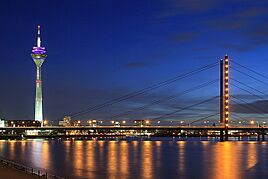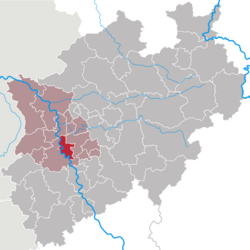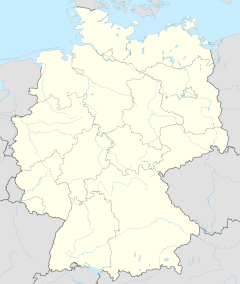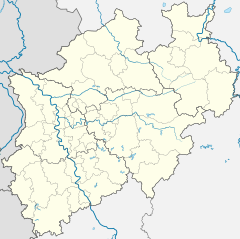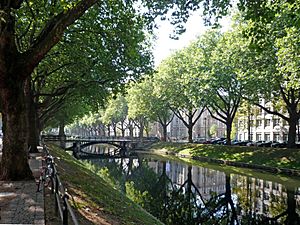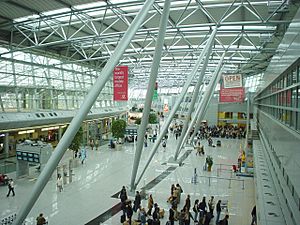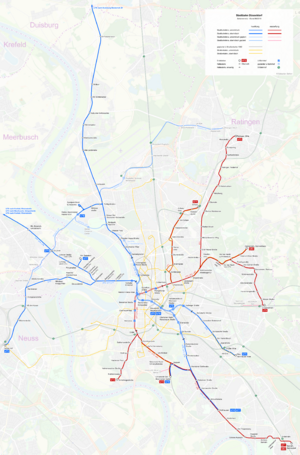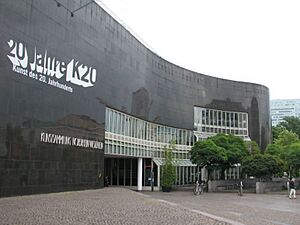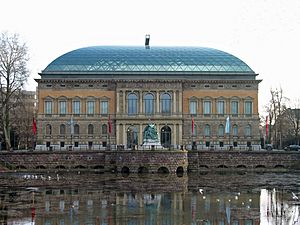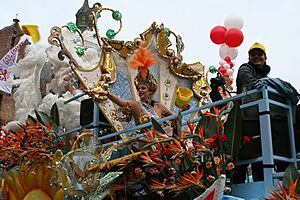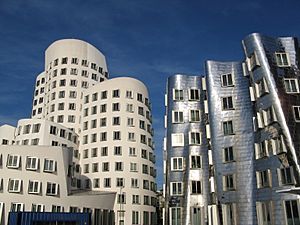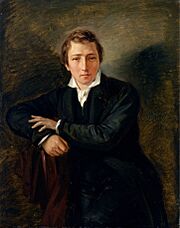Düsseldorf facts for kids
Quick facts for kids
Düsseldorf
Düsseldörp (Low Franconian)
Düsseldörp (Ripuarian) |
|||
|---|---|---|---|
|
nightly view of Düsseldorf with illuminated Rhine Tower and Rheinkniebrücke over the River Rhine
Neuer Zollhof
Kö-Bogen
Ständehaus
Königsallee
Girardet Bridge
Gardens of Benrath Palace
|
|||
|
|||
| Country | Germany | ||
| State | North Rhine-Westphalia | ||
| Admin. region | Düsseldorf | ||
| Subdivisions | 10 boroughs, 50 quarters | ||
| Area | |||
| • City | 217.41 km2 (83.94 sq mi) | ||
| Elevation | 38 m (125 ft) | ||
| Population
(2022-12-31)
|
|||
| • City | 629,047 | ||
| • Density | 2,893.37/km2 (7,493.79/sq mi) | ||
| • Urban | 1,220,000 | ||
| • Metro | 11,300,000 (Rhine-Ruhr) | ||
| Time zone | UTC+01:00 (CET) | ||
| • Summer (DST) | UTC+02:00 (CEST) | ||
| Postal codes |
40210–40629
|
||
| Dialling codes | 0211, 0203, 02104 | ||
| Vehicle registration | D | ||
Düsseldorf is a major city in Germany. It is the capital of North Rhine-Westphalia, which is Germany's most populated state. Düsseldorf is the second-largest city in this state, after Cologne. It is also the sixth-largest city in all of Germany. In 2022, about 629,047 people lived there.
The city gets its name from the small river Düssel. This river flows into the Rhine in Düsseldorf. Most of the city is on the east side of the Rhine River. Düsseldorf is a key part of the Rhine-Ruhr region. This is one of the biggest economic areas in the European Union.
The word -dorf means "village" in German. It's unusual for a big city like Düsseldorf to have this name. Düsseldorf is the largest city in the German part of the Low Franconian language area. These dialects are similar to Dutch.
Düsseldorf is a global center for business and money. It is famous for its fashion and trade fairs. Many big companies have their main offices here. The Messe Düsseldorf organizes many important trade shows. Düsseldorf Airport is Germany's fourth busiest airport. It is a key international airport for the busy Ruhr area.
Düsseldorf is the second-largest city in the Rhineland. It celebrates Rhenish Carnival every year. These celebrations are very popular in Germany. They are the third most popular after those in Cologne and Mainz.
The city has 22 universities and colleges. These include the Heinrich-Heine-Universität Düsseldorf and the Kunstakademie Düsseldorf (art academy). Famous artists like Joseph Beuys and Gerhard Richter studied there. Düsseldorf is also known for its electronic music and its large Japanese community. It is considered a "Beta+" world city. In 2012, it was ranked the sixth most livable city globally.
Contents
History of Düsseldorf
Early Times
Long ago, in the 7th and 8th centuries, small farming and fishing villages grew where the Düssel River meets the Rhine. This is how Düsseldorf began. The first time Düsseldorf was mentioned in writing was in 1135. It was called Dusseldorp back then.
A very important day for Düsseldorf was August 14, 1288. On this day, Count Adolf VIII of Berg gave the village special rights to become a city. This happened after a big fight called the Battle of Worringen. The Count of Berg and his allies won against the Archbishop of Cologne. This victory helped Düsseldorf become a city. A monument on the Burgplatz still remembers this day.
After this battle, Cologne and Düsseldorf became rivals. They competed in business. Today, this rivalry is mostly friendly, especially during the Karneval celebrations and in sports.
A market square grew by the Rhine, protected by city walls. In 1380, the dukes of Berg made Düsseldorf their capital. Many famous buildings were built in the centuries that followed. This included the Collegiate Church of St Lambertus.
Later, the city became the main home for the Wittelsbach Counts. Under Johann Wilhelm II (who ruled from 1690–1716), a huge art gallery was created in the city castle. But after he died, the art collection was moved to Munich.
World Wars
Düsseldorf faced tough times during the Napoleonic Wars. After Napoleon's defeat, the area became part of Prussia in 1815. The city grew a lot during the Industrial Revolution. By 1882, 100,000 people lived there, and this number doubled by 1892.
During World War I, Düsseldorf was bombed by British planes in 1914. In 1920, the city was a center for a big workers' strike.
During World War II, Düsseldorf was heavily bombed. It was a target during the RAF bombing campaign in 1943. The city also had prisons and camps where people were forced to work. These included Polish, Soviet, French, Dutch, and Sinti and Romani prisoners. American soldiers captured the city in April 1945. This happened after a local German resistance group helped them.
After the Wars
In 1946, Düsseldorf became the capital of the new state of North Rhine-Westphalia. The city was rebuilt quickly. Its economy grew fast, making Düsseldorf a strong and modern city once again.
What is Düsseldorf Like?
Weather and Nature
Düsseldorf is in the center of the Lower Rhine area. The Düssel River flows into the Rhine here. Most of the city is on the east side of the Rhine. The city is built on layers of mud, sand, and clay. The highest point is Sandberg, at 165 meters (541 feet). The lowest point is in Wittlaer, at 28 meters (92 feet).
Düsseldorf has a mild climate. Winters are not too cold, with little snow. Summers are mild to warm. The average temperature is 11.0°C (51.8°F). The city gets about 751 mm (29.6 inches) of rain each year. Winds usually come from the west.
Fun Facts About People
Düsseldorf is Germany's sixth-largest city. In 2022, it had 653,253 residents. The population grew a lot during the industrial age. It reached over 705,000 in 1962. After a small drop, the population has been growing again since the late 1990s.
About 18% of Düsseldorf's people are from other countries. Most of them are from Europe. The largest groups are from Turkey, Greece, and Poland. Düsseldorf also has the third-largest Japanese community in Europe, with about 11,000 people. The city also has the third-largest Jewish community in Germany.
Business and Money

Düsseldorf is a major center for telecommunications in Germany. Two of Germany's biggest mobile phone companies, Vodafone and E-Plus, are based here. Many foreign tech companies like Huawei and Ericsson also have offices.
The city is also a hub for advertising. There are 400 advertising agencies, including some of the largest in Germany. About 200 publishing houses are also in Düsseldorf.
Big companies like Peek & Cloppenburg (fashion), Uniper (electricity), and Henkel (consumer goods) operate here. Daimler AG builds Mercedes-Benz vans in Düsseldorf.
Since the 1960s, Düsseldorf has had strong ties with Japan. Many Japanese banks and companies have their European headquarters here. This is why Düsseldorf has such a large Japanese community.
The "Kö" (Königsallee) is a famous shopping street. It has luxury shops, designer stores, and art galleries. Rents here are among the highest in Germany.
Düsseldorf is an important financial center. Over 30,000 people work in finance and insurance. There are about 170 national and international financial groups. It also has one of Germany's eight stock exchanges. Major banks like HSBC and Deutsche Bank have big offices here.
Media
Important newspapers and magazines are published in Düsseldorf. These include Handelsblatt and Rheinische Post. Many filmmaking companies and TV channels like WDR are also located here. The Film- und Medienstiftung NRW helps fund films and new media. You can watch movies in many languages in Düsseldorf, including English, Spanish, French, and German.
Getting Around
Düsseldorf Airport
Düsseldorf Airport is about 8 kilometers (5 miles) north of the city center. You can easily get there by train or the S-Bahn. It has a special train station for long-distance trains. These are connected to the airport by the SkyTrain, which is an automatic people mover.
Düsseldorf Airport is Germany's fourth largest commercial airport. In 2019, 25.5 million passengers used it. It offers flights to 180 places on four continents. About 70 airlines use this airport.
Railway
Düsseldorf is a major train hub. More than 1,000 trains stop here daily. The Düsseldorf Central Station is in the city center. Local trams and light rail trains, called Düsseldorf Stadtbahn, help people get around. These also connect to nearby cities. The Central Station and Airport Station are linked to national and European high-speed train systems.
Taxis and Carsharing
Düsseldorf has 1320 official taxis. They are always ivory colored. You can pay with a credit card at the airport taxi stands. There are two main taxi companies: "Taxi-Düsseldorf" and "Rhein-Taxi."
You can also use carsharing services in Düsseldorf. Since 2012, you can rent cars for one-way trips. These cars can be parked almost anywhere in the city. Companies like Car2go and Greenwheels offer these services.
Roads and Cycling
North Rhine-Westphalia has the most highways in Germany. Düsseldorf is directly connected to several major highways.
The city is also part of national and international cycling paths. This includes the EV15 The Rhine Cycle Route. Düsseldorf was named a "Friend of Cyclists City" in 2007.
Culture and Fun
Düsseldorf has a rich cultural scene. It mixes old traditions with new art. The state art collection of North Rhine-Westphalia is world-famous. The Deutsche Oper am Rhein (opera) and the Düsseldorfer Schauspielhaus (theater) are also very well known.
Beer
Düsseldorf is famous for its Altbier. This is a special type of beer that means "old style beer." It's made using an older brewing method. The name "altbier" started in the 19th century. It helped tell these beers apart from the new pale lagers.
There are five breweries in Düsseldorf that make Altbier right in their pubs. These are Füchschen, Schumacher, Schlüssel, Uerige, and Brauerei Kürzer. Most of them are in the historic center, called Altstadt. Each of these breweries also makes a special, secret seasonal beer.
Music and Nightlife
Düsseldorf has been home to many important music artists. Especially famous are the electronic and krautrock bands. Kraftwerk is the most well-known example. They are seen as pioneers in electronic music.
Other influential bands from Düsseldorf include Neu! and La Düsseldorf. These groups greatly influenced rock, post-punk, and electronic music. The punk band Die Toten Hosen and the electronic/industrial band Die Krupps also started here.
Fashion and Fun
Düsseldorf has been Germany's fashion capital for many decades. It is also a big center for art. Many schools in Düsseldorf teach fashion design.
One of the biggest cultural events is the Karneval. It starts every year on November 11th at 11:11 a.m. The main event is a huge parade on Rosenmontag (Rose Monday). The Karneval ends on Aschermittwoch (Ash Wednesday).
Düsseldorf's Cartwheeler
The Düsseldorfer Radschläger (boy who does cartwheels) is said to be the city's oldest tradition. You can find the cartwheeler symbol on souvenirs. Many things in Düsseldorf are named after cartwheelers.
There are several stories about how the cartwheeling tradition began. The most famous one is linked to the Battle of Worringen in 1288. When Count Adolf won the battle, Düsseldorf became a city. People, especially children, were so happy that they ran through the streets doing cartwheels.
Another story says that a wheel broke on a wedding carriage. To stop bad luck, a boy supposedly grabbed the wheel and became a "living part" of it.
In the late 1800s, children doing cartwheels found they could earn money from travelers. They would shout, "a cartwheel for a penny!" This tradition is still alive today. The Alde Düsseldorfer Bürgergesellschaft von 1920 e. V. organizes an annual cartwheeler competition. It has been held every year since 1971. About 500 boys and girls take part.
You can see cartwheelers all over the city. They are on fountains, storm drains, and even a door knocker on the Church of Lambertus. In 2001, an art project called Radschläger-Kunst created over 100 cartwheeler sculptures. They are 2 meters (6.6 feet) tall and are placed around the city center.
Christmas Market
Every Christmas, Düsseldorf hosts one of Germany's largest Christmas markets. It runs from November 17th to December 23rd. Many tourists come to enjoy mulled wine and hot chocolate. They also watch craftsmen make glass and art. The market has a charming, old European feel.
Food and Drinks
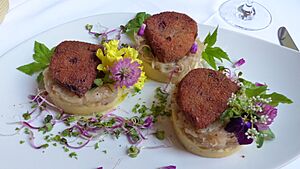
Traditional meals in the region include Rheinischer Sauerbraten. This is beef marinated in vinegar and spices, served with gravy and raisins. Another dish is Heaven and Earth (Himmel un Äd). It's black pudding with stewed apples and mashed potatoes. In winter, people enjoy Rhenish-style mussels and Reibekuchen (fried potato pancakes with apple sauce).
Düsseldorf is also known for its strong, Dijon-like mustard. It's served in a traditional pot called "Mostertpöttche." Vincent van Gogh even painted this mustard pot in 1884.
The city offers a wide variety of food, especially Asian cuisine. This is thanks to its large Japanese community. Düsseldorf's food scene has been praised by the Lonely Planet travel guide. The city also has several Michelin-starred restaurants.
Local specialties include:
- Halve Hahn: A half rye roll with butter, thick Gouda cheese, onions, mustard, paprika, and pickles.
- Himmel un Aad: Mashed potatoes and apples with slices of blutwurst (blood sausage). It's usually served with caramelized onions.
- Reibekuchen: Fried potato pancakes. They are often drizzled with beet syrup and served on pumpernickel bread with applesauce.
Rivalry with Cologne
Düsseldorf and Cologne have a "fierce regional rivalry." This rivalry includes carnival parades, football, ice hockey, and beer. People in Cologne prefer Kölsch beer, while people in Düsseldorf prefer Altbier. This rivalry is often seen as a "love-hate relationship."
Learning and Education
Heinrich Heine University Düsseldorf is in the southern part of the city. It has about 30,000 students. They study many subjects like science, math, computer science, philosophy, and medicine.
Other important schools include:
- The Clara Schumann Musikschule (music school).
- The Robert Schumann Hochschule.
- The Kunstakademie Düsseldorf (Academy of Fine Arts). This school is famous for artists like Joseph Beuys and Gerhard Richter.
- The Hochschule Düsseldorf (University of Applied Sciences).
- The AMD Academy of Fashion and Design.
- The Goethe Institute.
Düsseldorf also has international schools:
- International School of Düsseldorf
- Lycée français de Düsseldorf
- Japanische Internationale Schule in Düsseldorf
Cool Buildings and Places
- Rheinturm (TV tower): This is a city landmark. It is 240.5 meters (789 feet) tall. Its lights form the world's largest digital clock.
- The Neuer Zollhof: These are cool buildings designed by Frank Gehry in the Düsseldorf media harbor.
- The Colorium: An 18-story tower also in the media harbor.
- The Benrather Schloss (Benrath palace): A beautiful rococo castle.
- The Wilhelm Marx House: Built in 1922/24, it was Germany's first high-rise building.
- The ARAG-Tower: At 131 meters (430 feet), it is Düsseldorf's tallest office building. It was designed by Sir Norman Foster.
- Eight bridges cross the Rhine in Düsseldorf. They are also city landmarks.
- Königsallee: A famous street with luxury shops.
- Altstadt (Düsseldorf): The "old town" is the historic center. It has the old town hall from 1573. Today, it's known as "the longest bar in the world" because of its many pubs and restaurants.
- Düsseldorf-Hafen: The harbor area is a modern district.
- Kaiserswerth: A historic district with the ruined castle of Emperor Barbarossa.
- Hofgarten: An old city park.
- Schloss Jägerhof: An old hunting lodge in the Hofgarten, now a Goethe Museum.
Sports and Events
Düsseldorf's main football team is Fortuna Düsseldorf. They won the German championship in 1933 and the German Cup in 1979 and 1980. They play their games in the Merkur Spiel-Arena, which can hold 54,500 people. Düsseldorf was one of the host cities for the 1974 FIFA World Cup and will host games for the 2024 UEFA European Championship.
Other sports in Düsseldorf include ice hockey (the Düsseldorfer EG), and American football (the Düsseldorf Panther). The Düsseldorf Panther are one of Germany's most successful teams. Düsseldorf also has a successful rugby union team.
The city hosted the Eurovision Song Contest 2011.
Twin Towns – Sister Cities
Düsseldorf is connected to other cities around the world. These are called twin towns or sister cities:
 Reading, England, UK (1988)
Reading, England, UK (1988) Chemnitz, Germany (1988)
Chemnitz, Germany (1988) Haifa, Israel (1988)
Haifa, Israel (1988) Warsaw, Poland (1989)
Warsaw, Poland (1989) Chongqing, China (2004)
Chongqing, China (2004) Palermo, Italy (2016)
Palermo, Italy (2016) Chiba Prefecture, Japan (2019)
Chiba Prefecture, Japan (2019) Chernivtsi, Ukraine (2022)
Chernivtsi, Ukraine (2022) Moscow, Russia (1992); this partnership is currently paused.
Moscow, Russia (1992); this partnership is currently paused.
Düsseldorf also works with these cities:
 Toulouse, France (2003)
Toulouse, France (2003) Tenerife, Spain (2003)
Tenerife, Spain (2003) Shenyang, China (2004)
Shenyang, China (2004) Guangzhou, China (2006)
Guangzhou, China (2006) Montreal, Canada (2015)
Montreal, Canada (2015) Portland, Oregon, United States of America (2024)
Portland, Oregon, United States of America (2024)
Notable People
Many famous people were born in or are connected to Düsseldorf.
Born Before 1900
- Anne of Cleves (1515–1557), married to King Henry VIII.
- Johann Georg Jacobi (1740–1814), a writer.
- Heinrich Heine (1797–1856), a famous poet and writer.
- Felix Klein (1849–1925), a mathematician.
- Georg Wenker (1852–1911), a linguist.
- Elly Ney (1882–1968), a world-famous concert pianist.
Born After 1900
- Max Lorenz (1901–1975), a tenor singer.
- Helmut Käutner (1908–1980), a film director and actor.
- Luise Rainer (1910–2014), an actress.
- Jürgen Habermas (born 1929), a philosopher and sociologist.
- Wim Wenders (born 1945), a filmmaker and writer.
- Marius Müller-Westernhagen (born 1948), an actor and musician.
- Andreas Gursky (born 1955), a photographer.
- Andreas Frege (born 1962), "Campino", singer in the band Die Toten Hosen.
- Heike Makatsch (born 1971), an actress and singer.
- Erika Ikuta (born 1997), a Japanese actress.
Associated with Düsseldorf
- Robert Schumann (1810–1856), a composer who worked in Düsseldorf.
- Clara Schumann (1819–1896), a pianist and composer, wife of Robert Schumann.
- Emanuel Leutze (1824–1868), a painter from the Düsseldorf School.
Images for kids
See also
 In Spanish: Düsseldorf para niños
In Spanish: Düsseldorf para niños


